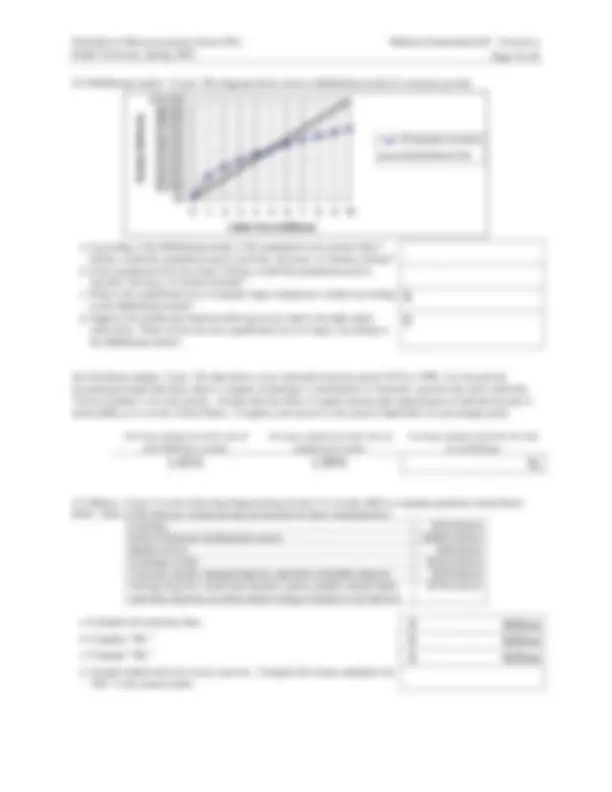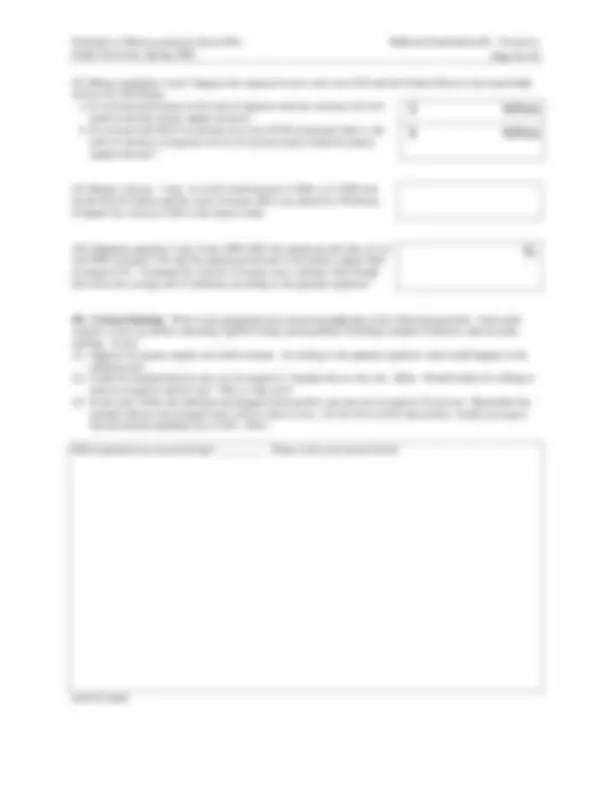




Study with the several resources on Docsity

Earn points by helping other students or get them with a premium plan


Prepare for your exams
Study with the several resources on Docsity

Earn points to download
Earn points by helping other students or get them with a premium plan
Community
Ask the community for help and clear up your study doubts
Discover the best universities in your country according to Docsity users
Free resources
Download our free guides on studying techniques, anxiety management strategies, and thesis advice from Docsity tutors
A midterm exam for principles of macroeconomics (econ 001) at drake university, spring 2002. The exam covers various topics such as potential gdp, unemployment, interest rates, gdp shares, and the malthusian model. It includes multiple choice and problem-solving questions.
Typology: Exams
1 / 4

This page cannot be seen from the preview
Don't miss anything!



Principles of Macroeconomics (Econ 001) Signature: Drake University, Spring 2002 William M. Boal Printed name:
INSTRUCTIONS: This exam is closed-book, closed-notes, but calculators are permitted. Numerical answers, if rounded, must be correct to at least 3 significant digits. Point values for each question are noted in brackets. Maximum total points are 100.
I. Multiple choice: Circle the one best answer to each question. [2 pts each: 20 pts]
(1) Potential GDP depends on all of the following except a. currency in circulation. b. technology. c. the capital stock. d. the labor force. e. no exceptions—it depends on all of the above.
(2) U.S. unemployment was highest in the a. 1910s b. 1930s. c. 1950s. d. 1970s. e. 1990s.
(3) According to the “job-rationing” theory of unemployment, wages in the labor market are a. above the equilibrium level. b. at the equilibrium level. c. below the equilibrium level. d. cannot be determined from the information given.
(4) Suppose the current capital stock is $10 trillion, this year’s gross investment is $1.5 trillion, and this year’s depreciation is $0.3 trillion. Next year’s capital stock will be a. $ 1.2 trillion. b. $ 8.5 trillion. c. $10 trillion. d. $11.2 trillion. e. $11.5 trillion.
(5) Over the last few centuries, output per worker in the world’s leading economies has a. decreased. b. remained constant. c. grown at a decreasing rate. d. grown at a constant rate. e. grown at an increasing rate.
(6) Human capital means a. “smart” devices that function like humans. b. buildings and equipment, divided by the number of workers. c. education and training. d. enlightened attitudes of business owners. e. ergonomically designed equipment.
(7) A “nonrival good” a. can be used by any number of people simultaneously. b. has no close substitute. c. is not protected by patents, copyrights, or licenses. d. is of the highest quality. e. is produced by noncompeting firms.
(8) Money, by definition, is a. accepted by everyone as payment. b. made of something valuable. c. produced by the government. d. the largest part of wealth. e. all of the above.
(9) Hyperinflation is caused by a. anxiety over the future. b. depreciation of the capital stock. c. rapid increase in the money supply. d. rising money velocity. e. technological stagnation.
(10) Most economists today believe that, on a graph like that below, the long-run relationship between inflation and unemployment is
a. vertical. b. horizontal. c. downward-sloping. d. upward-sloping.
Unemployment
Inflation rate
Drake University, Spring 2002
II. Problems: Insert your answer to each question in the box provided. Feel free to use the margins for scratch workonly the answers in the boxes will be graded. Work carefullypartial credit is not normally given for questions in this section.
(1) [Labor force: 6 pts] In the U.S. in February 2001, about 135.7 million people were employed and about 5. million people were unemployed, out of a total working-age population of 211.0 million people. Compute the following quantities:
b. The labor force participation rate (to the nearest tenth of a percentage point)
(2) [Interest rate: 6 pts] Suppose the interest rate is 3%. a. The opportunity cost of $1 of consumption today is how many dollars of consumption next year?
b. The opportunity cost of $1 of consumption next year is how many dollars of consumption today?
(3) [Interest rate and GDP shares: 10 pts] Consider the long-run model of GDP shares and the interest rate presented in lectures and in your text. According to this model, what are the effects of the two following policy scenarios (at the top of the table below) on the real U.S. interest rate, the exchange rate, and U.S. GDP shares in the long run? Write "increase," "decrease," or "no change" in each box. [Hint: First determine which curve shifts and in which direction.]
r
a. The government offers tax incentives for retirement saving.
b. The share of government purchases in GDP (G/Y) falls.
The real U.S. interest rate:
Consumption's share of GDP (C/Y):
Investment's share of GDP (I/Y):
The exchange rate (foreign currency per U.S. $): Net exports' share of GDP (X/Y):
(4) [Interest rate and GDP shares: 15 pts] Suppose the following three equations relate the shares of consumption (C), investment (I), and net exports (X) in total GDP (Y) to the real interest rate (r). In these equations, the GDP shares and the interest rate are expressed as percents.
Suppose further that the share of government purchases (G/Y) is fixed at 22 %. Compute the following. [Hint: Check your answer to be sure that the four GDP spending shares sum to 100%.] a. Interest rate (r)
d. Net exports' share of GDP (X/Y):
b. Consumption's share of GDP (C/Y):
e. Savings as a share of GDP (S/Y):
c. Investment's share of GDP (I/Y):
Drake University, Spring 2002
(8) [Money multiplier: 6 pts] Suppose the required reserve ratio were 0.05 and the Federal Reserve increased bank reserves by $20 billion. a. If everyone held money in the form of deposits only (no currency) by how much would the money supply increase?
b. If everyone held $0.15 in currency for every $1.00 in deposits (that is, the ratio of currency to deposits were 0.15) by how much would the money supply increase?
(9) [Money velocity: 3 pts] As of the fourth quarter of 2001, U.S. GDP was about $10,225 billion and the stock of money (M1) was about $1,170 billion. Compute the velocity of M1 to the nearest tenth.
(10) [Quantity equation: 3 pts] From 1990-1995, the annual growth rate of U.S. real GDP averaged 2.4% and the annual growth rate of the money supply (M1) averaged 6.4%. Assuming the velocity of money were constant, what should have been the average rate of inflation, according to the quantity equation?
III. Critical thinking: Write a one-paragraph essay answering only one of the following questions. Full credit requires correct economic reasoning, legible writing, good grammar including complete sentences, and accurate spelling. [4 pts] (1) Suppose the money supply were held constant. According to the quantity equation, what would happen to the inflation rate? (2) Could the nominal interest rate ever be negative? Explain why or why not. [Hint: Would lenders be willing to lend at a negative interest rate? Why or why not?] (3) In the early 1930s, the inflation rate dropped from positive one percent to negative 10 percent. Meanwhile the nominal interest rate dropped from 3.6% to close to zero. On the basis of this information , would you expect that investment spending rose or fell? Why?
Which question are you answering? _________. Please write your answer below:
[end of exam]